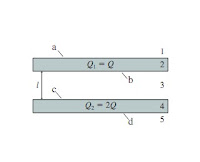Four point charges, A, B, C, and D, are placed at the corners of a square with side length L. Charges A, B, and C have charge + q, and D has charge − q. (see Figure 1)
Throughout this problem, use k in place of 1/(4πϵ0).
|
|
|---|
PART A:
If you calculate W, the amount of work it took to assemble this charge configuration if the point charges were initially infinitely far apart, you will find that the contribution for each charge is proportional to kq2/L. In the space provided, enter the numeric value that multiplies the above factor, in W.
SOLUTION:
We know that the work to assemble a charge configuration of two charges a distance r from each other is simply W = kq2/r
If we want to assemble three charges A, B, and C... you have to consider the distances between all of them
WABC = kq2/(rAB + rAC + rBC)
finally, to assemble four charges A, B, C, & D....
WABCD = kq2/(rAB + rAC + rAD + rBC + rBD + rCD)
Note, however, that this is for all positive charges. If there is a negative charge in there, you must subtract that distance rather than add it to the divisor.
Considering a square charge configuration with sides L, such as in figure 1... A, B, & C are positive & D is negative
rAB = L
rAC = L√2
rAD = L (-)
rBC = L
rBD = L√2 (-)
rCD = L (-)
⇒ W = kq2/(L + L√2 + (-L) + L + (-L√2) + (-L)
⇒ ∴ W = 0 × (kq2/L)
-----------------------------------------------------------------------------------------------------
PART B:
Which of the following figures depicts a charge configuration that requires less work to assemble than the configuration in the problem introduction? Assume that all charges have the same magnitude q. (Figure 2)
SOLUTION:
working through each option...
(a)
This one appears to be complicated at first, but really isn't if you consider trig.
The positive charges are equidistant from each other at a distance of L. This means that the negative charge is as far away from them as half of the distance between one of the positive charges and the corresponding line opposite it.
rAB = L
rAC = L
rAD = ½L⋅sin(60) (-)
rBC = L
rBD = ½L⋅sin(60) (-)
rCD = ½L⋅sin(60) (-)
Wa = kq2/(3L - (3/2)L⋅(0.866))
⇒ ∴ Wa = (1/1.7) × (kq2/L) = (0.5879)× (kq2/L)
(b)
rAB = L
rAC = 2L
rAD = 3L (-)
rBC = L
rBD = 2L (-)
rCD = L (-)
Wb = kq2/(4L - 6L)
⇒ ∴ Wb = (-1/2) × (kq2/L) = (-0.5)× (kq2/L)
(c)
This one is identical to the problem introduction problem, but multiplied by a factor of 2. The factor doesn't matter, so Wc = 0 × (kq2/L)
In this case, the greater work is actually the less work. By this I mean, the positive work represents the amount of work the system actually exhibits, that we don't have to do. If there is negative work, we have to make up that work in order to place the charges as desired.
Therefore, charge configuration (a) requires the least amount of work.
figure a


